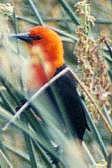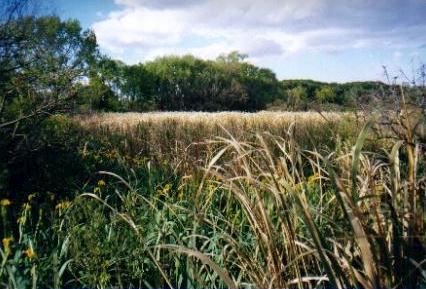Last update: September 2008
Portal en Español
|
|
Website created and maintained by: Alec
Earnshaw
Last update: September 2008 |
Marca aquí para ir al
Portal en Español |
| What
is the Ribera Norte nature reserve? Ribera Norte (full name "Refugio Natural Educativo de la Ribera Norte") is a nature reserve located on the coast of the Río de la Plata in the town of Acassuso, (borough of San Isidro), northern suburbs of the city of Buenos Aires, in Argentina. |
|
 Scarlet-headed Blackbird |
It
is a charming natural habitat covering about 10 hectares (25 acres). It
protects one of the last remaining wild stretches of coast of the Río
de la Plata. Many types of wild plants and animals live here, which can
be seen following a 400m trail that takes you around the grounds. One shining
example is the Scarlet-headed Blackbird (se photo), perhaps one of Argentina's
loveliest birds, that still nests in the reserve. The existence of the reserve helps of course to protect this rich habitat, while today it also serves an important educational purpose, since it is visited by many schools throughout the year. The land is government-owned (Municipalidad de San Isidro). The care and running of the reserve has been entrusted to a local NGO (for more information see Spanish-language webpage of the Asociación Ribera Norte). This NGO was founded for this very purpose, and does an excellent job in conservation, planning and ensuring that proper, sustainable use is made of the grounds. |
|
The
reserve is open to the public during the day, when conditions allow. It
does close in case of rain or high tides, and also for a day or two after
these events, so that the narrow trail can dry off without being damaged
by dozens of people trampling on the mud. See Opening
Times. |
|
|
One of the main priorities of Ribera Norte is the preservation of the local wildlife. Many species of plants and animals are found in the reserve and which are especially adapted to living and breeding in this sort of environment. Since this is low-lying land on the coast of the Río de la Plata, it floods frequently during high tides or windstorms. The water completely covers the reserve during peak tides. This flooding is a crucial ingredient of the life-cycle of many plants, which in turn provide shelter and food to many kinds of animals: insects, reptiles, birds and mammals that are native to this part of the world. Since similar wild places are no longer found in the San Isidro area - due to development - the continued existence of Ribera Norte is crucial to the survival of many species that would otherwise have long disappeared. This website contains many photos of the plants and animals that can be seen here. Check out the sections on FLORA and FAUNA. |
 View of the stands of reeds at Ribera Norte. Behind is the willow forest |
|
The reserve has various habitats: grasslands, reedbeds, a lagoon, ceibo forest (LEGUMINOSAE: Erythrina crista-galli), willow forest, aliso forest (COMPOSITAE: Tessaria integrifolia), etc. Each one of these habitats is marked by predominant plant species, which in turn supports certain types of animals. And since some of these animals are strongly attached to particular plant species, their existence depends on the conservation of the natural vegetation. |
|
|
|
The
reserve also serves a very important educational purpose. Throughout
the school year many youngsters visit the reserve as part of their curricular
activities. It is during these visits that many children have their very
first encounter with nature. The students are guided by specialists who
"open their eyes" to the wonders of the natural world. In spring and summer (September-March) the reserve is teeming with life, with plants in full bloom and many animals about. To mention just a few: the arrival of migratory birds, many butterflies making their flights and large lizards that are out of hibernation. In winter the landscape is equally attractive, and is visited by migratory birds from Patagonia escaping the cold south. |
|
The
purpose of this website is to point out the abundance and diversity of
wildlife in Ribera Norte, hoping that it will help the inhabitants of
this region become aware that we share our life with many other living
beings. Some of these life forms have incredible shapes and colours, but
are restricted to living in the very few wild places that still remain
unaltered. We humans MUST try to find a way to coexist with them, or they
will soon become extinct - dragging us the same way too! |
|